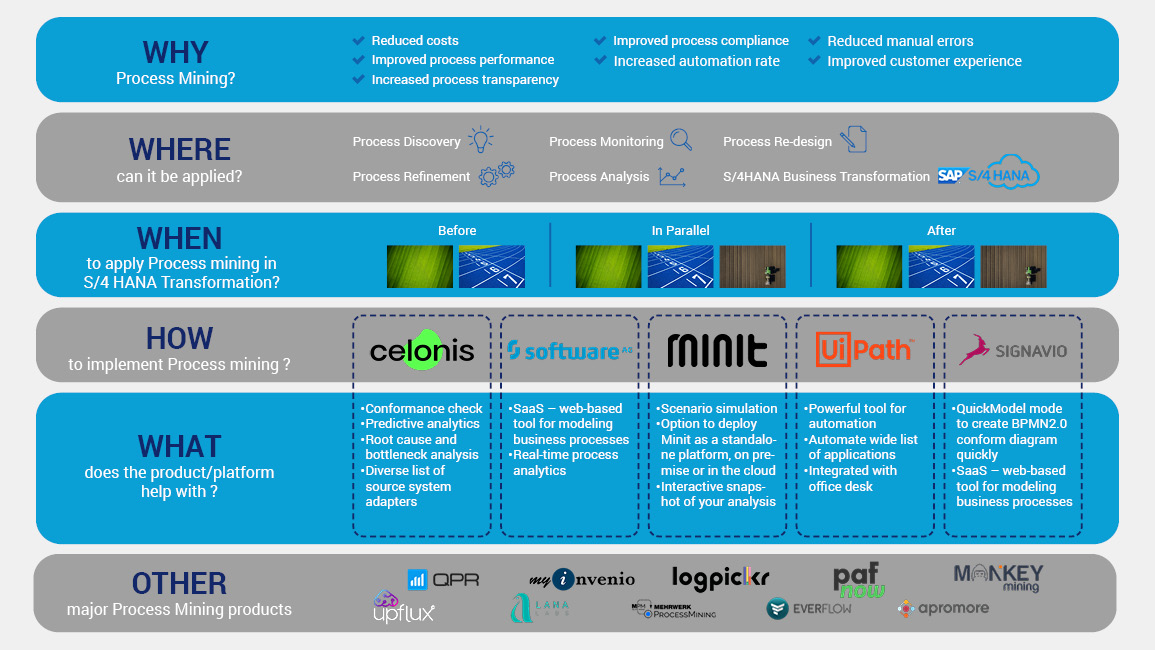What's in it for you in Process Mining? Akshata Shetty and Fahrudin Abazi guide you through the relevant questions to find the right path to process optimisation in your S/4 HANA transformation. Let’s get started!
The digitalization trend is encouraging businesses to find value in their organization’s operations. Whether you are a business that is currently on the verge of expanding their landscape or are at the very beginning of planning a completely new set-up - this is the perfect time to analyze your business processes to efficiently plan your expansion.
Do you really need Process Mining?
Whether in the Cloud or On-Premise, Process Mining will help you to uncover hard-to-detect inefficiencies and blockages. Usually, businesses start with an ideal business model. But over time and due to external factors, the processes are extended and molded to suit ever-changing requirements.
No matter the size of the business, its operation and working model are very complex and the problem can be so deeply hidden in the processes, that you cannot even analyze its root causes manually and if you do, it will involve a lot of guesswork on where the problem lies.
No more guesswork! Process mining analyzes your as-is processes and provides a visual, fact-based flow of events in the day-to-day activities of your business.
What you should ask yourself in the context of process mining
- Do you want to reduce costs in your organization by improving the performance of your
processes? - Do you want to make your processes more transparent?
- Do you want to improve process compliance?
- Do you want to increase the automation rate thereby reducing manual errors and improving customer experience?
- Do you want to leverage machine learning and artificial intelligence to recommend process improvements?
If you answered "Yes" to any of the questions above, then it is clear -you need Process Mining!
Is it really worth the hype?
Business process execution is tracked by modern information systems in their underlying databases. These huge amounts of operational event data are a valuable source to further develop and improve these processes. Process mining is the technology that captures the process by utilizing the captured data.
Process mining proves its value in many areas - Process Discovery, Process Analysis, Process Re-design, Process Monitoring, Process Refinement, and S/4HANA Business Transformation just to name a few.
The list of possible applications for process mining is not exhaustive, but it clearly shows that it is a powerful technology.
Understanding the complexity of the as-is systems and the IT landscape is both the biggest challenge and the biggest opportunity for companies that want to transform and digitize their business as part of a system transformation. Business insights from process mining can be used throughout the implementation lifecycle, from planning and design to rollout and operational monitoring. In fact, the important insights you may be looking for are just a click away.
This article aims to guide you specifically in your S/4 HANA Transformation journey. There are several challenges in an S/4HANA migration, for example high customization, unclean master data and non-harmonized business processes. Looking at these challenges means that it is necessary to understand your system before you can start migrating to S/4HANA.
When should you implement process mining in your S/4 HANA transformation journey?
In today's fierce market, even the smallest inefficiencies can lead to huge losses. Businesses are constantly striving to outpace their adversaries and that means redefining their operations to gain a competitive edge.
Let's look at the different stages when process mining would most benefit an organization's S/4 HANA Transformation project:
Before Planning the S/4 HANA transformation
Since brownfield approach aims for migration to a S/4 HANA system without disrupting the existing business processes, performing Process mining prior to brownfield migration would not be very beneficial.
Process Mining can be implemented at the start of both bluefield and greenfield implementation.
Adopting a greenfield approach would mean developing a system in a completely new environment from scratch - no legacy processes around! So you may ask, on what exactly do you perform Process Mining if the system is blank!?
The idea would be to perform process mining on the legacy system to identify the potential "inefficient" processes and making sure these are not carried over to the newly planned systems. This gives you the advantage of not having any unusable or unnecessary data or processes in the new systems.
Process mining in the legacy system before planning a migration would highlight all the work-arounds or redundant activities in the system which may potentially have a standard process or may be irrelevant in the S/4 HANA environment.
This, of course, is also true for a bluefield approach.
Parallel to the S/4 HANA transformation
Process mining can also be implemented in parallel with the S/4HANA transformation. However, both projects - the implementation of a process mining technology as well as the S/4HANA transformation - bring along some major challenges, such as resource commitment, novelty of the technology, partial cost intensity, etc. For these reasons, it is not advisable to run process mining primarily in parallel during the S/4HANA implementation.
In case of the decision to introduce process mining during a S/4HANA implementation project, for example due to time constraints, it would only make sense in the context of a greenfield and bluefield implementation. In this case, the process mining project runs in parallel with the SAP Activate method, starts in the Discover phase and ideally should end at the start of Explore phase.
SAP Activate consists of 6 phases: Discover, Prepare, Explore, Realize, Deploy and Execute. For the implementation approach of process mining, some phases of the Activate methodology can be used analogously. For example, the Discover phase can be used in parallel to identify the capabilities of the process mining solution, understand the business value and benefits of the solution to the organization, and determine the implementation strategy and roadmap in accordance with the understanding of the solution's capabilities.
After executing the S/4 HANA transformation
Implementing process mining after the S/4HANA transformation makes sense for customers for all the scenarios - brownfield, greenfield and bluefield. In the case of brownfield, as compared to implementing Process Mining before S/4HANA transformation, it reduces the cost and implementation effort.
The main effort in implementing process mining at the beginning is to connect the ERP system to the process mining tool, e.g., Celonis. This is a big advantage because we build the process mining technology on the latest ERP standard. On the other hand, for the greenfield and bluefield scenario, it also makes sense to build up process mining after the ERP has been converted to S/4 HANA technology. All new processes in the ERP have been designed and implemented, process mining could be used to monitor the newly implemented processes.
Also, if improvements are to be made to the new processes in day-to-day business, Process Mining can help to identify this improvement potential. With a process mining tool, we are then able to maintain the quality of the redesigned processes and bring more efficiency to the processes.
What are the available process mining Products?
According to PEAK Matrix ® Assessment 2021 on Process mining products, the current market leaders are Celonis, Software AG, Minit and UiPath followed closely by Signavio.
Celonis is very powerful and versatile tool with a variety of connectors to source systems. It is well suited for reducing bottlenecks and checking conformance of the processes to the ideal model, as well as automating process actions according to users’ needs using AI-recommended actions.
While Software AG’s ARIS has been known in the industry for quite some time as a process modelling tool, especially with its easy-to-use basic version, the company is now expanding into the field of real-time process analytics by providing connectors to common source systems like SAP (currently being rolled out).
With Minit, you have the option to deploy it as a standalone platform, on premises, or in the cloud, giving you the flexibility, you need to implement the system based on your business requirements and preferences. You can take an interactive snapshot of the state of your analysis and make it viewable to your colleagues, who can then see your work and the steps that you did.
UiPath is very effective where repetitive tasks are to be performed using multiple applications. It has the capability to record a user’s tasks performed on a wide list of applications and automate the tasks and streamline the process.
Signavio has a QuickModel mode for capturing which can also be useful for fast modeling. Simply create the basic structure of the diagram in QuickModel, then switch to the Editor to add more complex structures.

Detecon is agnostic with regard to the tools used. A selection is based exclusively on the respective business objectives.
Our recommendation
In general, we recommend to follow a Proof of Value approach to assess the use of BPM for a specific use case.
We would guide you through a process touching your S/4 HANA systems which will be assessed in detail with our process experts during a series of workshops with all stakeholders involved. The results will include a process map of all current stakeholders, a to-be process, as well as the data and systems involved throughout the process.
Post implementation, our experts will aim to provide all the help you need to analyze further potential for process mining, while enabling you to gradually take the lead, familiarize your teams with process mining and ensuring it is used wherever conditions are met.
Want to know more about our wide-range of service offerings? Please visit us!







